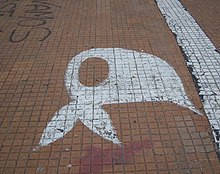Madres de Plaza de Mayo
The Madres de Plaza de Mayo ("Mothers of the Square of the May Revolution") is an organization of Argentine women whose children "disappeared" under the military dictatorship from 1976 to 1983 under initially unexplained circumstances ( Desaparecidos ). It is one of the most important human rights organizations in Argentina. During the military dictatorship, their protests initially focused on demanding the release of those arrested or information about their whereabouts. Afterwards, the Madres de Plaza de Mayo campaigned for a criminal law investigation of the human rights violations committed during the dictatorship and also campaigned for a memory of the victims.
Only gradually did it become clear that the systematic, secret disappearance of political opponents was part of the so-called dirty war (Guerra Sucia) of the military . After the transition to democracy, official investigations showed, among other things , that up to 30,000 people had been murdered in this way. The mothers belong - together with the Abuelas de Plaza de Mayo ( Grandmothers of the Plaza de Mayo ) - to the few people in Argentina who publicly protested against it. This put them in danger themselves, so their first chairwoman, Azucena Villaflor, also disappeared without a trace.
Overview
The name refers to the Plaza de Mayo , the square in front of the Presidential Palace in Buenos Aires , where women have met since the military dictatorship to protest the injustices of enforced disappearances that tore their families apart and to clarify the deeds and punish the To claim guilty party. Every Thursday, for the first time on April 30, 1977, they silently walk around the square for half an hour because standing protests were forbidden at the time. The Madres' white headscarf, worn out of mourning and protest, became a well-known symbol of their resistance and struggle for justice. Nélida Gómez de Navajas was one of the initiators.
The first leader of the Madres was Azucena Villaflor de Vicenti , she "disappeared" like many other Argentines. Her successor and today's leader is Hebe de Bonafini .
The amnesty laws and pardon orders, in particular the final point law and the law on the duty of obedience , which had long protected the military, were repealed during the tenure of President Néstor Kirchner , who ruled from 2003 to 2007, and were declared unconstitutional and therefore null and void by the Argentine Constitutional Court explained. During Kirchner's presidency, the Madres gave up their weekly marches. These were resumed in 2016 after Mauricio Macri took office after Macri had relativized the crimes of the military dictatorship. The weekly protests in the Plaza de Mayo, combined with the demand for an investigation into the crimes of the military dictatorship, continue to this day (as of 2019).
As a national institution, the Madres now run their own newspaper, bookstore, radio station and university. On the 30th anniversary, the now elderly mothers were honored with a ceremony in Buenos Aires and numerous events.
It is mainly thanks to the commitment of Latin American human rights activists and the commitment of members of Desaparecidos like the Madres that the UN Convention against Enforced Disappearances came into force on December 23, 2010 . The Convention implemented a new criminal offense in international law. It was not least a question of extending the term victim to family members of disappeared people in order to secure certain rights for them.
Awards
- 1992: Sakharov Prize for Freedom of Thought
- 1999: UNESCO Prize for Peace Education
- 1999: Methodist Peace Prize
In the 15th arrondissement of Paris , the Jardin des Mères et Grand-mères de la Place de Mai (Garden of the Mothers and Grandmothers of the Plaza de Mayo) was inaugurated in 2008 .
literature
- Gisela Klemt-Kozinowski (Ed.): The women from the Plaza de Mayo. Reading book human rights. Baden-Baden 1984, ISBN 3-7971-0245-3
- Sara Eleanor Howe: The Madres de Plaza de Mayo: asserting motherhood, rejecting feminism? (PDF; 69 kB) In: Journal of International Women's Studies. Volume 7, 2006, pp. 43-50.
- Andreas Fischer-Lescano : Global Constitution. The justification for the validity of human rights. Weilerswist, Velbrück 2005, ISBN 3-934730-88-4
- Marguerite Guzman Bouvard: Revolutionizing Motherhood. The Mothers of the Plaza de Mayo. Wilmington 1994, ISBN 0-8420-2486-7
See also
Web links
- Madres de Plaza de Mayo - Official Website
- Weltspiegel contribution: The children of those who have disappeared ( Memento from March 24, 2009 in the Internet Archive ) NDR, Sunday, October 12, 2008 ( video )
- Biographical interview with Inés Ragni and Lolín Rigoni (co-founders of the Madres de Plaza de Mayo) on March 10, 2016, in: Sources for the history of human rights, published by the working group Human Rights in the 20th Century.
- Sylvia Karl: Convention against Enforced Disappearances , in: Sources for the History of Human Rights, published by the Working Group on Human Rights in the 20th Century, May 2015, accessed on January 11, 2017.
Individual evidence
- ↑ Biographical interview with Inés Ragni and Lolín Rigoni (co-founders of the Madres de Plaza de Mayo). In: Sources on the history of human rights. Working Group on Human Rights in the 20th Century, March 10, 2016, accessed on December 21, 2016 .
- ↑ cf. also: Kiu Eckstein : One Life - Two Worlds. Biographical Notes in Times of Change. Hamburg 2017, ISBN 978-3-7439-3297-5 , pp. 128f.
- ^ Decision of the Constitutional Court
- ↑ Las Madres de la Plaza de Mayo realizan su marcha number 2,000 acompañadas de miles de argentinos. Retrieved March 11, 2019 .
- ↑ LAS MADRES REALIZARON SU MARCHA Nº 2133 EN PLAZA DE MAYO. In: Asociación Madres de Plaza de Mayo. February 28, 2019, Retrieved March 5, 2019 (Spanish).
- ↑ Sylivia Karl: Convention against Enforced Disappearances. In: Sources on the history of human rights. Working Group on Human Rights in the 20th Century, May 2015, accessed on January 11, 2017 .

